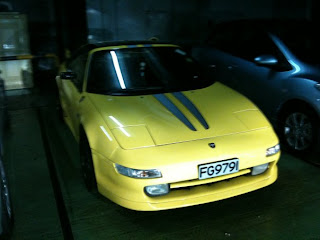Taxicabs of Hong Kong provide a taxi system. Most taxis are independently owned and operated, but some are owned by taxi companies, and the drivers are employees.
As of 2003, there were 18,138 taxis in Hong Kong, of which 15,250 were urban taxis, 2,838 were New Territories taxis, and 50 were Lantau taxis. Every day they serve about 1.1 million, 207,900 and 1,400 people respectively.
19th century
Sedan chairs and rickshaws awaiting fares on Queen's Road Central
During the early colonial times, sedan chairs were the only form of public conveyances. Public chairs were licensed, and charged according to tariffs which would be prominently displayed. Chair stands were found at all hotels, wharves, and major crossroads, and the sturdy chair bearers would clamour for the favour of his regular patronage.
Much the same as motor cars nowadays, private chairs existed, and were an important marker of a person's status. Civil officers' status was denoted by the number of bearers attached to his chair.
Their numbers peaked in about 1920, when 1,215 registered sedan chairs were on the road.
The rickshaw was first imported from Japan in 1870 by an American businessman. They were a popular form of transport for many years, peaking at more than 7,000 in the early part of the 20th century. These two modes vied for customers depending on their budget, haste, or terrain to be negotiated. The rickshaw was more rapid, but was not suited to climbing the steep terrain of Hong Kong Island[2]. Before Hong Kong's Peak Tram went into service in 1888, wealthy residents of The Peak were carried on sedan chairs by coolies up the steep paths to their residence, including former Governor Sir Richard MacDonnell's summer home, where they could take advantage of the cooler climate.
However, rickshaws' popularity waned after World War II. No new licenses for rickshaws have been issued since 1975, and licenses became non-transferable. Thus, a dying breed of only a few old men still plied their trade at the Edinburgh Place Ferry Pier, mainly for tourists. The rickshaw drawers charged HK$300 to go around the block. There were about eight in 1998, and only four left in 2002.
The last Sedan chair was reportedly abandoned in 1965, and since the relocation of the Central Star Ferry pier at the end of 2006 the rickshaws have disappeared.
The taxi trade is regulated by the Government, as are the fare scales. Taxis need a license to operate in Hong Kong. The government stopped issuing licenses in 1998, when there were a total of 18,138 in the territory. Existing licenses are transferable, and are traded on the open market. The going cost for a license is around HK$3 million.
The service area of the three types of taxis are defined by the Government in the 1960s. The need for the three different types was to avoid clustering of taxis in the more populated/profitable areas of the territory, and a shortage in others. All three types of taxis serve Hong Kong International Airport and Disneyland.
 More
More Contact
Contact Submit
Submit Premium
Premium


